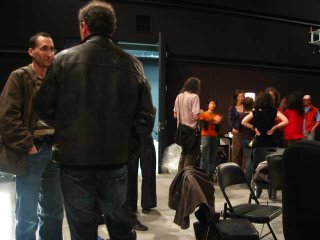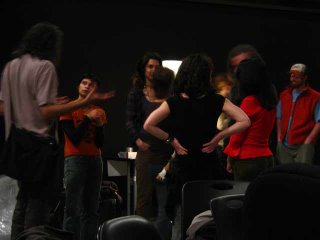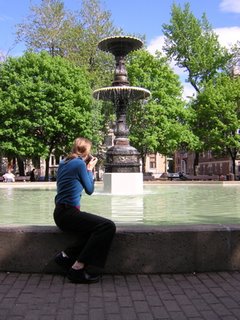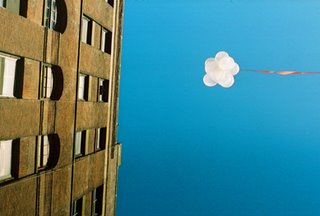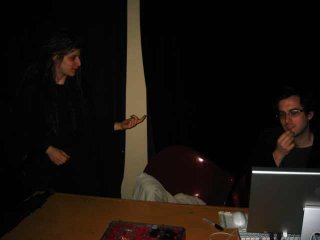Dancing the VirtualHi everyone - here are notes I've compiled based on what Brian and I consider a pivotal text for this event (Jose Gil's
La danse, le corps, l'inconscient). Since many of you are anglophones, I thought I would work through the text and try to bring out some points I consider relevant. My comments are in green - the black text are direct translations from Gil's text. I really look forward to seeing all of you tomorrow.
Erin
José Gil La danse, le corps, l’inconscient. Terrain n35 septembre 2000 Danser [text in black is loosely translated from Gil (page numbers refer to the print-out), text in green is by Erin]
THE NEXUS
1- what would be a nexus of dance movements? This nexus must be constructed.
3- What does it mean to experiment, to “try”? It is to arrive at “physical coordinates” where “energy” passes “naturally” (Cunningham). Forms compose themselves…depending on the destiny the dancer wants to give the energy, creating an intensive node or attenuating its momentum (élan), accelerating the speed, modulating the force of the movement. Energy operates throughout in both Cunningham’s vocabulary and Paxton’s (although Paxton will speak more in terms of “conscience”). I would prefer intensity.
4- Cunningham creates series that emanate from patchworks (not unlike James’ concept of the mosaic). The challenge will be to think both these concepts in terms of a wholeness that is not made up of parts. Gil makes this move through the notion of virtual fields “between” movements which he later calls nodes of intensification as well as differentiation without rupture.
- (coming from Duchamp): how does an object…after a certain “habituation” …become an object of art? Habituation is used throughout this article as closely tied to a tool (where a tendency would be more like a technique). Gil suggests for example that walking is not yet dancing because it remains goal-directed and thus embedded in a kind of habituation that would always reproduce itself. This will be relevant to the relational movement exercise (which will expand on this notion of habit toward a more Deleuzian idea that habit is never a strict repetition, but a repetition with a difference). The point Gil is trying to make is well-taken, though: that movement that becomes art (or dance) becomes so because of it becoming qualitatively more-than.
- to think the patchwork, Gil turns to the Deleuzian notion of series. Different or divergent series of gestures accomplished by the same body in a unique time-frame end up “integrating”… (this is the nexus of which he speaks above, a term also central to Whitehead’s thought). Gil suggests that these series become heterogeneous because their continuity depends on a certain chance or accident (hasard) – we could call this improvisation. The location of this improvisational tendency is in the between of the series and therefore not necessarily actualised. This suggests that a repetition of the series will always create a transduction (he mentions this later in the article) – which means a change of state (usually qualitative but also tendentially quantitative). Here we get close to the ways in which Deleuze is thinking repetition and difference in the chapter on the movement of thought. To “integrate” is to “diverge”.
5- The convergence therefore does not produce itself; on the contrary, and paradoxically, the divergence of the series builds accentuating itself (va en s’accentuant) or, better, accrues an autonomy and an intensity. Gil speaks here of what Cunningham calls “structural points” or nodes which are the instants where one series links to another. These virtual centres are sites of resonance between divergent series that produce a collective effect. How they connect is always singular, always differential [in Deleuze’s words, “elles vont en se différenciant]
-The points of contact or of crossing constitute nodes of intensification of the series. An interesting point here is that these “tensions” of the between can include non-danced gestures.
- If we have the impression that two series form a whole, it is because they enter into the same background continuity (continuité de fond) that composes the rhythm of the divergence that separates them… Rhythm here functions also as the virtual center, that will is almost-imperceptible and yet makes the movement become what it is. Rhythm as an intensifier of the between (where measure would work on the actual movement).Rhythm guarantees gaps (écarts) within continuity, enabling a movement of differentiation without rupture modulating time, speed, distance internal to intervals, without destroying the line of flux of the energy.
6- The choreographic nexus implies a background continuity of the circulation of energy, even if, on the surface, the series collide or separate off from one-another, or break. In fact, a choreography is composed of multiple strata of time and space. The background continuity, as a stratum of assemblage for all strata (strate d’agencement de toutes les strates), guarantees the nexus, the logic proper to the composition of all its movements.
THE QUASI-ARTICULATION OF THE BODY
- Gil suggests that dance is not composed like a language (where language is understood as a combinatorial system of signification) because it is impossible to cut the movements of the body into units – where these units would be like phonemes of “natural” language [this comment is similar to what Bergson says about movement in his introduction to Matter and Memory. Langer makes the same point in “Discursive and Presentational Forms”]. Gil highlights the fact that in movement there is no such “unity” that could be separated from its relation to the other “units” so that a clear boundary could be drawn between one movement and another (this is further developped in Gil’s Metamorphoses of the Body). Here, he suggests that there is always a sliding or a piggy-backing of units assembled and assembling. A little later he will talk about the movement of a hand always implicates micro-movements of the elbow and the shoulder, slight changes in balance, etc. To understand only the “mechanics” of movement is not to understand movement as such. Movement here becomes aligned with “quality”…
7- The dancer is therefore not simply a “physical” body (in the context of a purely “actual” body) but an expressive body that can fill itself with sense or become bloodless, absent, empty (like the psychotic body…)… The expressive body can also become the oversaturated body. As the movement becomes more-than (expressive, oversaturated), the dance becomes world rather than function. The expression is not of a subject buit of the world where the world is what is danced.
- quasiarticulation: the articulation of the body creates sense that is different from the sense created in language (closer to symbolism in the way Whitehead talks about it). Since the body is not quite articulated (in the linguistic sense), Gil says that its movements emerge from a quasi-articulation. It is this quasi-articulation that assures [the body’s] mobility, its operativity, its integration in space, keeping it from falling into amorphous immobility or into the inexpressivity of a pure object.
8- what articulates itself in the body are not unities of movement but entire zones of space. Because these zones cannot be strictly differentiated (since one zone drags with itself part of another zone) the body remains quasi-articulated. Since there is this piggy-backing of zones (like the strata), there is a quasi-syntax to the body which always remains singular, even while it inscribes itself in a margin of indetermination. Due to this margin of indetermination, the “zones” remain dynamic (similar to the concept of exfoliation in Gil’s Metamorphoses of the Body). This is why each gesture will remain at once unique and common.
OVERARTICULATION
9- Finally, if we consider the danced gesture, this quasi-articulation of the zones of the body and the overlapping of movements this implies lead to a sort of overfragmentation of the gestures.
10- Dance brings the body into movement because the body is already in movement… The body moves always imperceptibly because it is always in tensional equilibrium.
- Balance produces movement (metastable equilibrium). This metastability automultiplies the gesture – where the gesture at the microscopic level proves always to be composed of a multiplicity of gestures – implying what Gil calls an overfragmentation. Movement thus becomes a continuum of microgestures such that one gesture always composes itself with(in) others. This concept of overfragmentation is equivalent to an overarticulation. Overarticulation is the surplus of movement overactualized (and therefore rebecoming virtual). In this movement of overfragmentation of the gesture…the tendency is toward the abolition of the gesture as sign: tending toward the incarnation of sense. Sense here seems to me to be close to symbolic reference in Whitehead. [sign is not used in a Deleuzian sense but in a more purely linguistic sense].
11- Sense does not here pre-exist movement – sense emerges from movement (and particularly from movement’s virtual tendencies as seen in overfragmentation and overarticulation).
THE IMMANENCE OF MOVEMENT
11- Cunningham wanted to multiply movements to the physical limits of the body: overfragmentation of gestures opens the way for the passage of energy and facilitates its flow.
- In the danced movement, sense becomes action. It seems to me that for Gil when sense becomes action – or when the imperceptible becomes real – we have the plane of immanence of movement. Immanence realises the sense in the movements of the body. … a constitution of a plane that permits the danced movements to attain the point of fusion about which Cunningham speaks. This point of fusion is the “virtual center” or “structural point” discussed earlier, a becoming-moment where the dance and the dancer are fused in body-spirit – a becoming-dance of world. (Whitehead makes frequent use of fusion in a similar sense).
12- We will no longer be able to affirm that what makes the nexus of the oeuvre is ineffable, because it is there, realised in the immanence of sense in the dancing of bodies. This plane of immanence will emerge from the points of contact between the series, creating a fusion or an extreme intensification where matter and form are no longer opposed and through which the body becomes more-than. (Speaking about dance and music, Gil states that musical notes are actions of the body, vibrations of corporeal movement.) Gil thus explains that the dancer creates his/her plane of immanence by transforming the quasi-articulation into an overarticulation. The dance translates the mass of embodied and embedded sense into its intensive journey…
CONTACT IMPROVISATION
13- To create a plane of immanence while dancing, at least two conditions are required: that body and thought become one in the movement (Cunningham’s concept of fusion); that the movement of the body be infinite, which implies that it can assemble with other dancing bodies.
THE UNCONSCIOUS COMMUNICATION OF BODIES
17- Gil underlines that the idea of consciousness does not imply a “pure consciousness” but a “consciousness of the body” which propels an intensive osmosis of mutual impregnation (through the contact).
THE CONSCIENCE OF THE BODY, HOLES, COMMUNICATION
17- If there is an opening toward the unconscious that is transmitted without consciousness knowing the transmitted content, it is because a dynamism particular to the consciousness of a body (of each dancer) begins…: consciousness opens, decenters itself, loses its reference points, fills itself with “holes.”
18- After Paxton, Gil calls this a swiss-cheese-consciousness (a working model for consciousness). This “consciousness” operates not as the transmitter of sense (the creator of a movement, for example) but as an opening through which movement can happen that is “too quick for thought”. These are defined as virtual movements.
19- Paxton calls this virtuality of movement the small-dance and suggests that this virtuality is perceived as real through the contact of contact improvisation.
- Important here is the notion that we do not respond strictly to actual movements, but perhaps even more so to virtual –pre or –over movements. It is in this sense that we dance the plane of immanence of movement.







